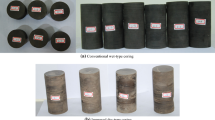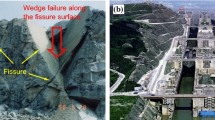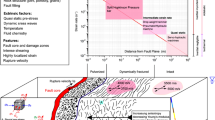Abstract
The microstructure of rock plays a vital role in the deformation and fracturing process when subjected to external loading. Conglomerate, being a pivotal part of unconventional reservoir, is characterized by a distinct composition structure and high degree of heterogeneity. Thus, a proper understanding of the impact of microstructure on the mechanical properties of conglomerate is crucial. We conduct uniaxial and triaxial compression tests on conglomerate samples, accompanied by monitoring acoustic emission events and ultrasonic wave velocity. Experimental results show that: (1) conglomerate fails in tension under uniaxial compression, but in shear fracture or cataclastic flow with volume expanding under triaxial compression; (2) the deformation transforms from brittle to ductile with increasing confining pressure. Two failure modes may exist in the brittle–ductile transition regime, namely, shear fracture and cataclastic flow; (3) the relationship between the mechanical characteristics and average gravel size is consistent with the “Hall–Petch” empirical relationship. The confining pressure required for brittle–ductile transformation reduces with larger average gravel size. Microscopic observation demonstrates that two gravels contacting with each other may fail in Hertzian fractures. Shear slip and rotation of gravel occurs under triaxial compression. We propose a conceptual model to describe the deformation of conglomerate under different confining conditions and compare the deformation properties of conglomerate with sandstone.
Highlights
-
The effects of microstructural and micromechanical properties on the deformation of conglomerate deformation are studied.
-
Both the peak strength and the brittle–ductile transition pressure reduce with higher average gravel size.
-
Discrepancy between gravel and matrix deformation dominates the cracks initiation, while the location of gravel affects the propagation.






















Similar content being viewed by others
References
Arnott RWC (2003) The role of fluid- and sediment-gravity flow processes during deposition of deltaic conglomerates (Cardium Formation, Upper Cretaceous), west-central Alberta. Bull Can Pet Geol 51:426–436. https://doi.org/10.2113/51.4.426
Baud P, Schubnel A, Wong TF (2000) Dilatancy, compaction, and failure mode in Solnhofen limestone. J Geophys Res Solid Earth 105:19289–19303. https://doi.org/10.1029/2000JB900133
Baud P, Klein E, Wong T-F (2004) Compaction localization in porous sandstones: spatial evolution of damage and acoustic emission activity. J Struct Geol 26:603–624. https://doi.org/10.1016/j.jsg.2003.09.002
Baud P, Hall S, Heap MJ, Ji Y, Wong TF (2021) The brittle‐ductile transition in porous limestone: failure mode, constitutive modeling of inelastic deformation and strain localization. J Geophys Res Solid Earth 126(5). https://doi.org/10.1029/2020jb021602
Bésuelle P, Baud P, Wong T (2003) Failure mode and spatial distribution of damage in Rothbach sandstone in the brittle–ductile transition. Pure Appl Geophys 160:851–868. https://doi.org/10.1007/978-3-0348-8083-1_4
Bieniawski ZT, Bernede MJ (1979) Suggested methods for determining the uniaxial compressive strength and deformability of rock materials: Part 1. Suggested method for determining deformability of rock materials in uniaxial compression. Int J Rock Mech Min Sci Geomech Abstr 16(2):138–140
Bobet A (2000) The initiation of secondary cracks in compression. Eng Fract Mech 66:187–219. https://doi.org/10.1016/S0013-7944(00)00009-6
Boggs S Jr (2014) Principles of sedimentology and stratigraphy. Pearson Education, London
Brace WF (1961) Dependence of fracture strength of rocks on grain size. In: Proceedings of the 4th symposium on rock mechanics, University Park, pp 99–103
Brace WF (1964) Brittle fracture of rocks. In: Judd WR (ed) State of stress in the earth’s crust. Elsevier, New York, pp 110–178
Cannon NP, Schulson EM, Smith TR, Frost HJ (1990) Wing cracks and brittle compressive fracture. Acta Metall Mater 38(10):1955–1962. https://doi.org/10.1016/0956-7151(90)90307-3
Cao J, Zhang Y, Hu W, Yao S, Wang X, Zhang Y, Tang Y (2005) The Permian hybrid petroleum system in the northwest margin of the Junggar Basin, northwest China. Mar Pet Geol 22:331–349. https://doi.org/10.1016/j.marpetgeo.2005.01.005
Cheng YT, Zhemin CMCZ (1999) Scaling relationships in conical indentation of elastic-perfectly plastic solids. Int J Solids Struct 36:1231–1243. https://doi.org/10.1016/S0020-7683(97)00349-1
Fredrich JT, Evans B, Wong T-F (1989) Micromechanics of the brittle to plastic transition in Carrara marble. J Geophys Res Solid Earth 94:4129–4145. https://doi.org/10.1029/JB094iB04p04129
Fredrich JT, Evans B, Wong TF (1990) Effect of grain size on brittle and semibrittle strength: implications for micromechanical modelling of failure in compression. J Geophys Res Solid Earth 95:10907–10920. https://doi.org/10.1029/JB095iB07p10907
Friesen OJ, Dashtgard SE, Miller J, Schmitt L, Baldwin C (2017) Permeability heterogeneity in bioturbated sediments and implications for waterflooding of tight-oil reservoirs, Cardium Formation, Pembina Field, Alberta, Canada. Mar Pet Geol 82:371–387. https://doi.org/10.1016/j.marpetgeo.2017.01.019
Hao Z, Fei H, Hao Q, Liu L (2018) The world’s largest conglomerate type oilfield has been discovered in the Junggar Basin of China. Acta Geol Sin (Engl Ed) 92:394–395
Hart BS, Plint AG (2003) Stratigraphy and sedimentology of shoreface and fluvial conglomerates: insights from the Cardium Formation in NW Alberta and adjacent British Columbia. Bull Can Pet Geol 51:437–464. https://doi.org/10.2113/51.4.437
Hirth G, Tullis J (1989) The effects of pressure and porosity on the micromechanics of the brittle-ductile transition in quartzite. J Geophys Res Solid Earth 94(B12):17825–17838. https://doi.org/10.1029/JB094iB12p17825
Hoek E (2002) Hoek–Brown failure criterion-2002 edition. Proceedings of the Fifth North American Rock Mechanics Symposium 1:18–22
Jia H, Ji H, Wang L, Gao Y, Li X, Zhou H (2017) Reservoir quality variations within a conglomeratic fan-delta system in the Mahu sag, northwestern Junggar Basin: characteristics and controlling factors. J Petrol Sci Eng 152:165–181. https://doi.org/10.1016/j.petrol.2017.03.002
Ju Y, Liu P, Chen J, Yang Y, Ranjith PG (2016) CDEM-based analysis of the 3D initiation and propagation of hydrofracturing cracks in heterogeneous glutenites. J Nat Gas Sci Eng 35:614–623. https://doi.org/10.1016/j.jngse.2016.09.011
Ju Y, Chen J, Wang Y, Gao F, Xie H (2018) Numerical analysis of hydrofracturing behaviors and mechanisms of heterogeneous reservoir glutenite, using the continuum-based discrete element method while considering hydromechanical coupling and leak-off effects. J Geophys Res Solid Earth 123:3621–3644. https://doi.org/10.1029/2017JB015092
Kandula N, Cordonnier B, Boller E, Weiss J, Renard F (2019) Dynamics of microscale precursors during brittle compressive failure in Carrara marble. J Geophys Res Solid Earth 124(6):6121–6139. https://doi.org/10.1029/2019JB017381
Kang X, Hu W, Cao J, Jin J, Wu H, Zhao Y, Wang J (2018) Selective dissolution of alkali feldspars and its effect on Lower Triassic sandy conglomerate reservoirs in the Junggar Basin, northwestern China. Geol J 53(2):475–499. https://doi.org/10.1002/gj.2905
Kang X, Hu W, Cao J, Wu H, Xiang B, Wang J (2019) Controls on reservoir quality in fan-deltaic conglomerates: insight from the Lower Triassic Baikouquan Formation, Junggar Basin, China. Mar Pet Geol 103:55–75. https://doi.org/10.1016/j.marpetgeo.2019.02.004
Khanlari GR, Heidari M, Noori M, Momeni A (2016) The effect of petrographic characteristics on engineering properties of conglomerates from Famenin Region, Northeast of Hamedan. Iran Rock Mech Rock Eng 49(7):2609–2621. https://doi.org/10.1007/s00603-016-0929-9
Krézsek C, Filipescu S, Silye L, Maţenco L, Doust H (2010) Miocene facies associations and sedimentary evolution of the Southern Transylvanian Basin (Romania): implications for hydrocarbon exploration. Mar Pet Geol 27:191–214. https://doi.org/10.1016/j.marpetgeo.2009.07.009
Li L, Meng Q, Wang S, Li G, Tang C (2013) A numerical investigation of the hydraulic fracturing behaviour of conglomerate in Glutenite formation. Acta Geotech 8:597–618. https://doi.org/10.1007/s11440-013-0209-8
Li N, Zhang SC, Ma XF, Zou SY, Chen M, Li SH (2017) Experimental study on hydraulic fracture propagation law of conglomerate reservoir. J Rock Mech Eng 36(10):10. https://doi.org/10.13722/j.cnki.jrme.2017.0159(in Chinese)
Liu K, Ostadhassan M, Bubach B (2016a) Applications of nano-indentation methods to estimate nanoscale mechanical properties of shale reservoir rocks. J Nat Gas Sci Eng 35:1310–1319. https://doi.org/10.1016/j.jngse.2016.09.068
Liu P, Ju Y, Ranjith PG, Zheng Z, Chen J (2016b) Experimental investigation of the effects of heterogeneity and geostress difference on the 3D growth and distribution of hydrofracturing cracks in unconventional reservoir rocks. J Nat Gas Sci Eng 35:541–554. https://doi.org/10.1016/j.jngse.2016.08.071
Liu P, Ju Y, Gao F, Ranjith PG, Zhang Q (2018) CT Identification and fractal characterization of 3-D propagation and distribution of hydrofracturing cracks in low-permeability heterogeneous rocks. J Geophys Res Solid Earth 123:2156–2173. https://doi.org/10.1002/2017jb015048
Luo SL, Ge HK, Wang JB, Zhou W, Shen YH, Liu PY, Liu JT (2021) Numerical simulation study on the crack propagation of conglomerate. Royal Society Open Science 8(7):202178. https://doi.org/10.1098/rsos.202178
Liu J, Ge H, Mou S, Wang X, Wang J (2022a) Characterization of meso-structure of glutenite reservoirs by ultrasonic characteristics and the velocity heterogeneity. J Petrol Sci Eng 208:109436. https://doi.org/10.1016/j.petrol.2021.109436
Liu J, Ge H, Zhang Z, Wang X, Wang J (2022b) Influence of mechanical contrast between the matrix and gravel on fracture propagation of glutenite. J Petrol Sci Eng 208:109639. https://doi.org/10.1016/j.petrol.2021.109639
Louis L, Wong T-F, Baud P (2007) Imaging strain localization by X-ray radiography and digital image correlation: deformation bands in Rothbach sandstone. J Struct Geol 29:129–140. https://doi.org/10.1016/j.jsg.2006.07.015
Ma X, Rudnicki JW, Haimson BC (2017) Failure characteristics of two porous sandstones subjected to true triaxial stresses: applied through a novel loading path. J Geophys Res Solid Earth 122:2525–2540. https://doi.org/10.1002/2016jb013637
Ma Z, Gamage RP, Zhang C (2020) Application of nanoindentation technology in rocks: a review. Geomech Geophys Geo-Energy Geo-Resources 6:1–27. https://doi.org/10.1007/s40948-020-00178-6
Mahabadi OK, Randall NX, Zong Z, Grasselli G (2012) A novel approach for micro-scale characterization and modeling of geomaterials incorporating actual material heterogeneity. Geophys Res Lett 39:1303. https://doi.org/10.1029/2011GL050411
Mahabadi OK, Tatone BSA, Grasselli G (2015) Influence of microscale heterogeneity and microstructure on the tensile behavior of crystalline rocks. J Geophys Res Solid Earth 119:5324–5341. https://doi.org/10.1002/2014JB011064
Mahmic O, Dypvik H, Hammer E (2018) Diagenetic influence on reservoir quality evolution, examples from Triassic conglomerates/arenites in the Edvard Grieg field, Norwegian North Sea. Mar Pet Geol 93:247–271. https://doi.org/10.1016/j.marpetgeo.2018.03.006
Martin CD, Chandler NA (1994) The progressive fracture of Lac du Bonnet granite. Int J Rock Mech Min Sci Geomech Abstr 31:643–659. https://doi.org/10.1016/0148-9062(94)90005-1
Menéndez B, Zhu W, Wong TF (1996) Micromechanics of brittle faulting and cataclastic flow in Berea sandstone. J Struct Geol 18:1–16. https://doi.org/10.1016/0191-8141(95)00076-P
Nie Y, Zhang G, Wen J, Li S, Zhou D (2021) Cyclic injection to reduce hydraulic fracture surface roughness in glutenite reservoirs. Int J Rock Mech Min Sci. https://doi.org/10.1016/j.ijrmms.2021.104740
Pijnenburg R, Spiers CJ (2020) Microphysics of inelastic deformation in reservoir sandstones from the seismogenic center of the Groningen gas field. Rock Mech Rock Eng. https://doi.org/10.1007/s00603-020-02215-y
Rui Z, Guo T, Feng Q, Qu Z, Qi N, Gong F (2018) Influence of gravel on the propagation pattern of hydraulic fracture in the glutenite reservoir. J Petrol Sci Eng 165:627–639. https://doi.org/10.1016/j.petrol.2018.02.067
Scott TE, Nielsen KC (1991) The effects of porosity on the brittle–ductile transition in sandstones. J Geophys Res Solid Earth 96(B1):405–414. https://doi.org/10.1029/90JB02069
Simpson C (1985) Deformation of granitic rocks across the brittle–ductile transition. J Struct Geol 7:503–511. https://doi.org/10.1016/0191-8141(85)90023-9
Song Z, Yang L, Ying C, Nan W, Jian D (2007) Comprehensive evaluation of heterogeneity conglomerate reservoirs-taking conglomerate reservoirs in Qizhong and Qidong area of Karamary oil field as an example. Petrol Geol Exp 29(4):415–419. https://doi.org/10.11781/sysydz200704415
Stanchits S, Vinciguerra S, Dresen G (2006) Ultrasonic velocities, acoustic emission characteristics and crack damage of basalt and granite. Pure Appl Geophys 163:975–994. https://doi.org/10.1007/s00024-006-0059-5
Wang J, Ge H, Liu J, Shen Y, Zhang Z, Luo S, Liu D (2022) Effects of gravel size and content on the mechanical properties of conglomerate. Rock Mech Rock Eng. https://doi.org/10.1007/s00603-021-02760-0
Wei Z, Patrick B, Teng-fong W (2010a) Micromechanics of cataclastic pore collapse in limestone. J Geophys Res. https://doi.org/10.1029/2009JB006610
Wei Z, Baud P, Vinciguerra S, Wong TF (2010b) Micromechanics of brittle faulting and cataclastic flow in Alban Hills tuff. J Geophys Res Solid Earth 116:B6. https://doi.org/10.1029/2010bJB008046
Wong T-F (1990) Mechanical compaction and the brittle–ductile transition in porous sandstones. Geol Soc Lond Spec Publ 54:111–122. https://doi.org/10.1144/GSL.SP.1990.054.01.12
Wong T-F, Baud P (2012) The brittle-ductile transition in porous rock: a review. J Struct Geol 44:25–53. https://doi.org/10.1016/j.jsg.2012.07.010
Wong TF, David C, Zhu W (1997) The transition from brittle faulting to cataclastic flow in porous sandstones; mechanical deformation. J Geophys Res Solid Earth 102(B2):3009–3025. https://doi.org/10.1029/96JB03281
Wu SR, Yan TZ, Jian WX (1996) Experimental study on brittle-ductile transition deformation of marbled rock. J Earth 17(z1):104–111 (in Chinese)
Xu L, Evans B (2010) Strain heterogeneity in deformed Carrara marble using a microscale strain mapping technique. J Geophys Res Solid Earth 115:B4. https://doi.org/10.1029/2009JB006458
Yan J, Jie F, Min W, Li Z, Hu Q, Jing C (2018) Rock fabric and pore structure of the Shahejie sandy conglomerates from the Dongying depression in the Bohai Bay Basin, East China. Mar Pet Geol 97:624–638. https://doi.org/10.1016/j.marpetgeo.2018.07.009
Yang S-Q, Jing H-W, Wang S-Y (2012) Experimental investigation on the strength, deformability, failure behavior and acoustic emission locations of red sandstone under triaxial compression. Rock Mech Rock Eng 45:583–606. https://doi.org/10.1007/s00603-011-0208-8
Yang SQ, Ju Y, Gao F, Gui YL (2016) Strength, deformability and X-ray micro-CT observations of deeply buried marble under different confining pressures. Rock Mech Rock Eng 49:1–18. https://doi.org/10.1007/s00603-016-1040-y
Zaima K, Katayama I (2018) Evolution of elastic wave velocities and amplitudes during triaxial deformation of Aji granite under dry and water-saturated conditions. J Geophys Res Solid Earth 123:9601–9614. https://doi.org/10.1029/2018jb016377
Zhang J, Wong TF, Davis DM (1990) Micromechanics of pressure-induced grain crushing in porous rocks. J Geophys Res Solid Earth 95:341–352. https://doi.org/10.1029/JB095iB01p00341
Zhou Y et al (2018) Multifractal study of three-dimensional pore structure of sand-conglomerate reservoir based on CT images. Energy Fuels 32(4):4797–4807. https://doi.org/10.1021/acs.energyfuels.8b00057
Zhu H, Zhang Q, Zhang L (2013) Review of research progresses and applications of Hoek–Brown strength criterion. Yanshilixue Yu Gongcheng Xuebao/chin J Rock Mech Eng 32(10):1945–1963
Zonneveld J-P, Moslow TF (2004) Exploration potential of the Falher G shoreface conglomerate trend: evidence from outcrop. Bull Can Pet Geol 52:23–38. https://doi.org/10.2113/52.1.23
Zou Y et al (2017) Experimental study on the mechanism of hydraulic fracture growth in a glutenite reservoir. J Struct Geol 97:37–47. https://doi.org/10.1016/j.jsg.2017.02.012
Acknowledgements
The corresponding author appreciates the financial support from the project ZR2020YQ44 supported by Shandong Provincial Natural Science Foundation, and the Natural Science Foundation Project of China (No.: 51909138). The data for conglomerate in triaxial compression condition are available from https://doi.org/10.6084/m9.figshare.19930406 or by contacting the corresponding author.
Author information
Authors and Affiliations
Corresponding author
Ethics declarations
Conflict of interest
The authors declare that there are no conflicts of interest.
Additional information
Publisher's Note
Springer Nature remains neutral with regard to jurisdictional claims in published maps and institutional affiliations.
Rights and permissions
Springer Nature or its licensor (e.g. a society or other partner) holds exclusive rights to this article under a publishing agreement with the author(s) or other rightsholder(s); author self-archiving of the accepted manuscript version of this article is solely governed by the terms of such publishing agreement and applicable law.
About this article
Cite this article
Li, J., Duan, K., Meng, H. et al. On the Mechanical Properties and Failure Mechanism of Conglomerate Specimens Subjected to Triaxial Compression Tests. Rock Mech Rock Eng 56, 973–995 (2023). https://doi.org/10.1007/s00603-022-03110-4
Received:
Accepted:
Published:
Issue Date:
DOI: https://doi.org/10.1007/s00603-022-03110-4




